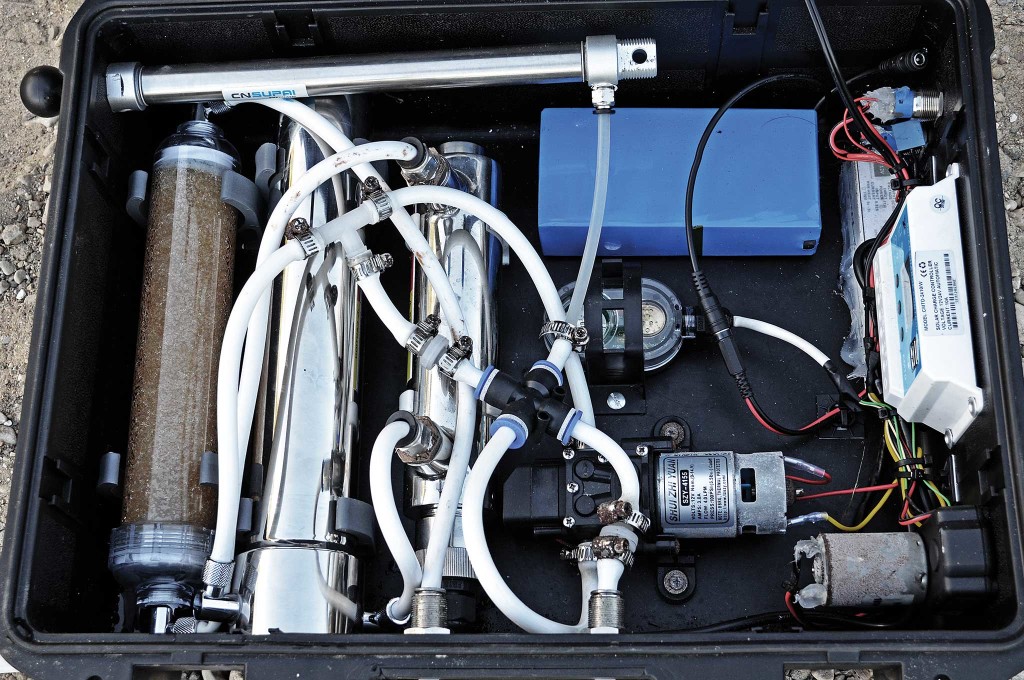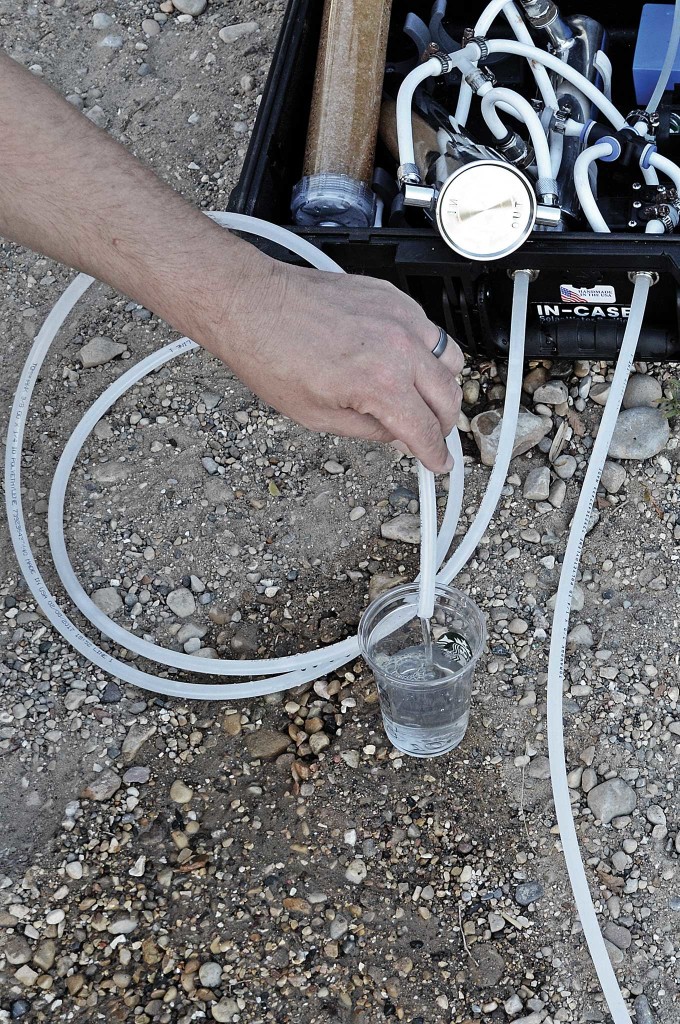RECOIL OFFGRID Gear IN-CASE Water Filtration System Review
In This Article
Make no mistake, this isn't your granddad's water filter. It is, however, one of the fastest and highest-capacity portable water filters this writer has ever seen.
The IN-CASE Water Filtration System was designed by Rich Gilbreath, one of the owners of a mom-and-pop prepper store called SHTF and Go, located in Burlington, Wisconsin. According to the manufacturer, when the IN-CASE is used properly, it'll remove 99.999 percent of all bacteria, cysts, parasites, and heavy metals. And it does so with a flow rate of almost 1 gallon per minute. Weight and transportation issues aside, you could take a 55-gallon drum to your local pond or creek and fill it with filtered water in about an hour.
The IN-CASE uses an electric pump to pull water through a prefilter, then forcing it through a silver impregnated ceramic filter with silver-activated charcoal. From there, the water is pushed through an ultraviolet (UV) sterilizer and then ionizing resin, which takes care of any heavy metals that might be present in the water.

The 12-volt DC pump is powered by three 10-watt solar panels that attach to the outside of the filter case. One panel is permanently attached, and the other two are affixed with strong magnets. The system is foolproof in that the panels can only be installed one way. The panels are light, flexible, and add almost no weight to the system. The 30 total watts generate about 1.5 amps. You can let the panels soak up the sun all day long and operate the pump at night using the internal battery. The pump is maintenance-free, with an expected life span of about 10,000 hours.
The battery will operate the filtration system under normal conditions for about six hours. As a bonus, there are two USB ports so the battery can be used to charge a cell phone or other devices. The battery is rated for about 1,000 charges. If needed, it can also be charged using the included international wall charger.
Survival is all about redundancy, and the IN-CASE has that in spades. If the sun isn't shining, there's a dynamo crank that'll generate the juice needed. If that fails, there's also a stainless steel manual pump option.
Under normal operating conditions, the IN-CASE will pump and filter about 50 gallons of water per hour. The output rate is slightly lessened when the UV system is employed. The UV light also uses more electricity, which means the battery will last three or four hours as opposed to six. There are two power buttons on the outside of the case. The top button is for the UV light, and the bottom is for the pump.
If a leak develops inside the unit, an alarm will sound.
The IN-CASE requires a little assembly before the first use. However, there's nothing that requires tools. When the unit arrives, it's ready to take out into the field. Everything can be assembled while sitting on a riverbank or the shore of a pond.
The battery must be plugged into the charge controller. If you take the IN-CASE when traveling by air, you'll need to disconnect the battery in order to be TSA compliant.

Everything is unpacked and assembled. The manual push-pull pump is located at the back of the unit with the knob on the...
The ceramic filter is packed inside its stainless steel housing, but needs to be unwrapped before using. Remove the housing and pull the filter from inside, peel off the plastic protective coating, and attach the filter to the housing base. The ceramic filter will need to be cleaned on a regular basis, though the frequency will depend upon how dirty the source of water may be. A distinct reduction in the system's output and speed will indicate when the filter needs attention. Simply remove the filter and clean it with the scrub pad included with the system.

Toss the water intake out into the pond. After priming, clean water begins to run from the output hose.
The intake and output tubes are simple press-fit attachments. The intake tube runs approximately 20 feet, and the output is about half that length. The prefilter slides over the stainless steel water pickup. Tie the lanyard tight, but make sure you can loosen the knot to remove it for cleaning and storage. The prefilter can be rinsed out when it becomes dirty. If it becomes misplaced or torn, virtually any fabric can be used, as the purpose is merely to limit the amount of dirt and debris that could enter the filter. The IN-CASE comes with one prefilter.
Attach the solar panels to the outside of the case, drop the intake into water, and you're ready to go.
The 20 feet of intake tube means you can stand on shore and toss the intake out into the pond or body of water without having to immerse yourself in it.
The electric pump cannot pull water more than 10 feet vertically, so in those situations the manual pump must be used. The manual pump may also be used to prime the electric pump, but this isn't absolutely necessary.
The power switches for the pump are located on the side of the unit. Push both buttons in, and the pump will start up. Once water has filled the ionizing chamber, turn on the juice. Of course, the pump will require electricity, so either the sun must be shining or the battery needs to be charged.
The pump does make noise, but isn't very loud at all, especially with the case closed. It sounds similar to a toy windup boat. If noise is a concern, you can use the manual pump to provide clean water with very little sound.
Once the unit is running in earnest, water flows from the output almost as fast as a kitchen faucet. It's clean, clear, and ready to drink.
We took the IN-CASE to a local pond for some real-world testing. The assembly took about 20 minutes, but most of that was spent on one-time operations, such as unpacking and assembling the ceramic filter. Once the unit is fully assembled, it may be stored and transported that way.
After assembly, putting it into operation consists of tossing the intake hose into the source water, putting a container at the end of the output hose, and turning the unit on. We primed the pump manually to test that function and found it took a fair amount of effort to draw the water through about 12 feet of hose and the filter. Not impossible, but it was a bit of a cardio workout.
The water in the pond was predictably dirty, and the water flowing from the output hose appeared to be as clear as normal bottled water. It tasted, well, like water is supposed to taste. The IN-CASE doesn't lend any sort of aftertaste to the water, unlike chemical purifiers such as chlorine tablets or iodine drops. We suffered absolutely no ill effects from consuming the filtered water, either.
The largest drawback to the system is the weight. While the unit packs nicely into the case, at 30 pounds it isn't something that'll be easy to lug around during a bug-out. The IN-CASE is, however, perfect for a family or group who needs a reliable method of producing clean water in large quantities.
Another reason the IN-CASE Water Filtration System might be best suited for a group is the price. It currently retails for $1,799, not much more than a large manually operated purifier.
All in all, it's a very impressive system filled with redundancies. Each unit is assembled by hand, and Rich insists customers call him upon receipt of their units so he can walk them through the assembly process. That level of customer service isn't seen very much nowadays.
IN-CASE Solar Water Purifier
www.SHTFandGo.com
Don’t miss essential survival insights—sign up for Recoil Offgrid's free newsletter today!
Read articles from the next issue of Recoil Offgrid: Issue 24
Read articles from the previous issue of Recoil Offgrid: Issue 22
Check out our other publications on the web: Recoil | Gun Digest | Blade | RecoilTV | RECOILtv (YouTube)
Editor's Note: This article has been modified from its original version for the web.
 STAY SAFE: Download a Free copy of the OFFGRID Outbreak Issue
STAY SAFE: Download a Free copy of the OFFGRID Outbreak Issue
No Comments